Clonmel: Difference between revisions
Created page with '{{Infobox town |name=Clonmel |irish=Cluain Meala |county=Tipperary |picture=Clonmel.jpg |picture caption=The Quays, Clonmel. |os grid ref=S199229 |latitude=52.3539 |longitude=-7.…' |
No edit summary |
||
| Line 14: | Line 14: | ||
|constituency=Tipperary South | |constituency=Tipperary South | ||
}} | }} | ||
'''Clonmel''' is the [[county town]] of [[Tipperary]] | '''Clonmel''' is the [[county town]] of [[County Tipperary|Tipperary]]. It is located in the South Riding on the county's border with [[County Waterford]] which is here marked by the [[River Suir]]. Clonmel is the largest town in its county. It is in the [[Barony of Iffa and Offa East]]. The 2011 census recorded a population in the borough of 15,793, and another 2,115 in the rural environs of the town. | ||
The town is noted in Irish history for its resistance to the Cromwellian army which sacked both [[Drogheda]] and [[Wexford]]. | The town is noted in Irish history for its resistance to the Cromwellian army which sacked both [[Drogheda]] and [[Wexford]]. | ||
Revision as of 09:34, 14 October 2014
| Clonmel Irish: Cluain Meala | |
| County Tipperary | |
|---|---|
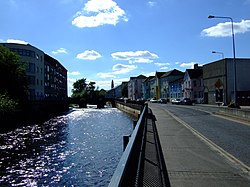 The Quays, Clonmel. | |
| Location | |
| Grid reference: | S199229 |
| Location: | 52°21’14"N, 7°42’42"W |
| Data | |
| Population: | 15,793 (2011) |
| Dialling code: | 052 |
| Local Government | |
| Council: | South Tipperary |
| Dáil constituency: |
Tipperary South |
Clonmel is the county town of Tipperary. It is located in the South Riding on the county's border with County Waterford which is here marked by the River Suir. Clonmel is the largest town in its county. It is in the Barony of Iffa and Offa East. The 2011 census recorded a population in the borough of 15,793, and another 2,115 in the rural environs of the town.
The town is noted in Irish history for its resistance to the Cromwellian army which sacked both Drogheda and Wexford.
Name
The name 'Clonmel' is derived from the Irish name Cluain Meala meaning "honey meadow" or "honey vale". It is not clearly known when it got this name and many suppose that it come from fertility of soil and richness of country in which it is situated.[1]
History
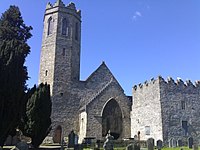
Town walls
Clonmel grew significantly in the Middle Ages, and many remainders of this period can be found in the town. A small section of the town walls remain in place near Old St Mary's Church, which is one of the main architectural features of the town.
Old St Mary's was originally built in the 13th century or earlier but has been reconstructed or renovated on numerous occasions. The church was fortified early in its history, the town being strategically important, initially for the Earls of Ormonde, and later the Earl of Kildare. Some fortified parts of the church were destroyed or damaged during the Cromwellian occupation.One of the former entry points into the town is now the site of the 'West Gate', a 19th-century reconstruction of an older structure. There were originally three gates in the walled town, North, East and West - with the South being protected by the river Suir and the Comeragh Mountains. The 'West Gate' is now an open arched entrance on to O'Connell street, the main street of the town.
Corporation regalia
Under a charter granted by King James I, Clonmel became a Free Borough on 5 July 1608, and the Mayor and officers of the town were granted power to "name, elect and constitute one Swordbearer and three Sergeants-at-Mace". The present sword and two silver maces date only from Cromwellian times. The sword, with a Toledo blade, was donated by Sir Thomas Stanley in 1656 and displays the Arms and motto of the town. The larger mace is stamped 1663.[2]
Cromwellian period
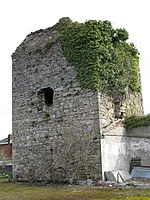
Oliver Cromwell laid siege to Clonmel in May 1650 during his campaign in Ireland. The walls were eventually breached, but Hugh Dubh O'Neill, the commander of the town's garrison, inflicted heavy losses on the New Model Army when they tried to storm the breach. That night, O'Neill, deciding that further resistance was hopeless due to a lack of ammunition, led his soldiers and camp followers out of the town under cover of darkness. The story is told that Cromwell became suspicious of O'Neill's desperate situation when a silver bullet was discharged by the townspeople at his troops outside the walls.[3] The following morning, 18 May 1650, mayor John White was able to surrender the town on good terms as Cromwell was still unaware of the garrison's escape just hours before. Although feeling deceived, he did not put the inhabitants to the sword as occurred elsewhere.
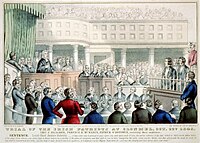
19th century
In 1848 a group of Young Irelanders made a failed attempt at rebellion near Ballingarry. The leaders were captured and brought to Clonmel for trial.[4] The event was followed with great interest internationally and for its duration brought journalists from around the country and Britain to the overcrowded courthouse. The malefactors, Thomas Francis Meagher, Terence MacManus and Patrick O'Donoghue and William Smith O'Brien were sentenced to be hanged, drawn and quartered, the last occasions such a sentence was handed down in Ireland. When delivering the guilty verdict, the foreman of the Grand Jury, R M Southcote Mansergh stated:
We earnestly recommend the prisoner to the merciful consideration of the Government, being unanimously of opinion that for many reasons his life should be spared.[5]
The sentences of O'Brien and other members of the Irish Confederation were eventually commuted to transportation for life to Van Diemen's Land.
A conspiracy to rescue the prisoners on 8 November led by John O'Leary and Philip Gray was betrayed, and resulted in the arrest at 'The Wilderness' of seventeen armed rebels led by Gray.[6]
20th century
At Clonmel in 1912 the Labour Party was founded, by James Connolly, James Larkin and William O'Brien, as the political wing of the Irish Trade Union Congress.[7]
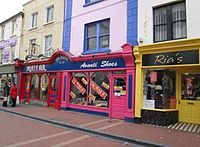
Geography
The town stands mainly on the northern bank of the River Suir; the river here marks the county boundary and the small suburbs on the south bank stand in County Waterford. The lower Suir valley is surrounded by the Comeragh Mountains to the south with Slievenamon northeast of the town.
Flood defences
The River Suir floods the local area after very heavy rainfalls in the up-river drainage basin of 839 square miles. The Office of Public Works (OPW) completed and installed a Flood Forecasting System which was used for the flood events of January 2008 and January 2009.The flood of 2004 had a flow of 77,869 gallons a second while the flood of 2000 had a flow of 77,649 gallons a second. The 2004 was the worst since the 1946 which had a flow of 105,365 gallons a second.Phase 1 of the Clonmel Flood Defence (planned to cope with a 100-year flood) started in 2007. It was scheduled to be completed by late 2009. Phases two and three are for completed by the winter of 2011/2012. The flood defence consists of demountable barriers, walls and earth banks.
By mid-2009, flooding occurred at the Gashouse Bridge, Coleville Road, Davis Road, the Quays and the Old Bridge. Clonmel is not tidal as the tide turns above the Miloko chocolate crumb factory in Carrick-on-Suir. Flood waters spill onto the land above Miloko on the County Waterford side of the river.
Commerce

In recent times Clonmel environs has become the home to many large multi-national companies, particularly in the medical area. The two biggest medical companies in the town are Abbott and Boston Scientific, both of which manufacture implantable devices. Bulmers cider, also known as Magners outside of Ireland, is brewed in a complex a mile or so east of the town, and a small orchard serving the brewery can be seen from the road when approaching Clonmel from that direction.
Media
- Radio: Tipp FM
- Newspapers:
- The Nationalist, founded in 1890, (Clonmel-based, weekly, covering both Clonmel town and Tipperary). It was formed to represent the views of the nationalist community in Tipperary, which led to the first editor being jailed under the Coercion Act on charges that he had intimidated a cattle dealer for taking a farm from which tenants had been evicted.[8]
- South Tipp Today, a freesheet founded in 1995
- The Sporting Press, published and printed in Clonmel
Culture
Museums
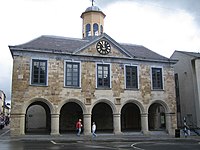
Tipperary County Museum tells the history of County Tipperary from the Stone Age to the present. It also holds many special exhibitions each year. It is the first custom-built county museum in Ireland.
The Main Guard was a civic building until 1810 when it was converted to shops. During recent restoration, some of its sandstone columns were found to have been 'reclaimed' from the now demolished abbey of Inislounaght at Marlfield. It has been used in the past as a Tholsel or office to collect tolls, duties and customs dues, a place for civic gatherings and as a court. It now houses an exhibition showing the historic development of Clonmel, including a model of the town as it appeared in the 13th century.
The South Tipperary Arts Centre opened in 1996. Its programme mixtures arts and cultural events. It hosts 12 exhibitions per year and presents a classical music season in Spring and Autumn. It holds a number of adult and child based art and music course during the course of the year. It is also home to several groups who meet there in an informal setting, including a local writer's guild.
Festivals
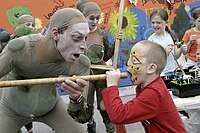
For nine days from the first week-end of July, the town hosts the annual Clonmel Junction Festival. It consists of a mix of street theatre, rock, traditional and world music. Several international acts visit the festival each year. In the last few years, young local bands have also had an opportunity to showcase their talents. Children from local schools and community groups are encouraged to participate with support from local artists.
Clonmel is home to the International Film Festival Ireland, which focuses on independent films. Its inaugural event was during September 2009[9] and ran for five days. It has become an annual event, occurring every September.[10] The 2010 event expanded to included a Youth Film Festival, that showcased locally made short films.[11]
Music
Banna Chluain Meala (literally translating as 'Clonmel band') was founded in 1971. Originally a brass band, Banna Chluain Meala later developed as a brass and reed band, which included concert, marching and fieldshow performances. The band also has a colour guard section which enhances marching and fieldshow performances. The total complement of the band has ranged from 100 to 150 members throughout the years. The band has travelled widely abroad to the United Kingdom, Holland and France and represented Ireland at an International Festival in Cheb in the Czech Republic in 2004 to celebrate the new entrants to the European Union. Banna Chluain Meala is one of Ireland's most honoured bands. They hold concert band championship titles on national and international levels. As a marching band they have had unparalleled success nationally, being crowned IMBA Irish champions in the highest division on eleven occasions (1991, 1995, 1996, 1997, 1998, 1999, 2006, 2007, 2009, 2010, 2011). They have also had success abroad, most notably as Open Class champions at the British Youth Band Championships at Wembley in 1994.
Clonmel has hosted the Irish traditional music festival, the Fleadh Cheoil, on five occasions from 1992-94 inclusive, and again in 2003 and 2004.
One of the better known songs concerning Clonmel is The Gaol of Clúain Meala written by a Cork man, Jeremiah Joseph Callanan at the turn of the 19th century.[12] It was revived by the celebrated balladeer Luke Kelly in the 1960s.
Music Venues in Clonmel include The Piper Inn famous for hosting a show for Irish Rock legends Thin Lizzy.
Clonmel in literature
Vertue rewarded, or The Irish princess, (1693), one of the earliest romance novels written in the English language, tells the story of 'Merinda' from High Street, Clonmel and a Government officer stationed in the town during the Jacobite war.[13]
Raymond Chandler's 1939 novel The Big Sleep, features Rusty Regan as a main character: "A big curly-headed Irishman from Clonmel, with sad eyes and a smile as wide as Wilshire Boulevard."[14]
Sport
- Football: Clonmel Celtic
- Athletics: Clonmel Athletic Club
- Rugby: Clonmel Rugby Club
- Cricket: Clonmel Cricket Club
- Horse Racing and Coursing: Clonmel is noted in greyhound circles for being the home of the annual National Hare Coursing meeting in early February at Clonmel Racecourse located in the Powerstown area of the town. Included in this event is the prestigious Ladies' International Open Meeting and the coursing derby. At this time each year, Clonmel's population is swollen by a large influx of sports people from Ireland, the United Kingdom, and from as far afield as Australia, New Zealand, the United States and the Middle East.
- Rowing and boat building: Clonmel has two clubs associated with recreational activity on the river Suir, both of which are based in Irishtown:
- Clonmel Rowing Club, founded in 1869 and one of the oldest sporting clubs in the town.
- Workmen's Boat Club, established in 1883
- Gaelic Games:
- Clonmel Commercials GFC
- St Mary's Hurling Club (also plays camogie)
- Clonmel Óg, set up in 1984
- Moyle Rovers GAA, just outside the town
Outside links
| ("Wikimedia Commons" has material about Clonmel) |
- [1] LIT Clonmel
- [2] CYTE
- Junction Festival
- Tipperary County Museum, Clonmel. Tipperary County Museum, Clonmel.
- Radio documentary on Suir Island, Clonmel RTÉ 'Seascapes' (22 January 2010)
- Irish Rail Clonmel Station
References
- ↑ History of Clonmel (1907)
- ↑ Burke, William P. (1907). History of Clonmel. N. Harvey & co. for the Clonmel Library Committee. pp. 235–237. http://www.archive.org/details/historyclonmel00burkgoog.
- ↑ Curry, William (1853). The Dublin University Magazine. v. 42. William Curry, Jun., and Co.,. http://books.google.com/?id=5NoRAAAAYAAJ&pg=PA329&dq=clonmel+%22silver+bullet%22. Retrieved 27 June 2009.
- ↑ McConville, Seán (2003). Irish political prisoners, 1848-1922: theatres of war. Routledge. p. 42. ISBN 978-0-415-21991-4. http://books.google.com/?id=rLrsi3hpXIQC&pg=PA42&dq=%22tried+for+high+treason+before+the+irish+lord+chief+justice%22#v=onepage&q=%22tried%20for%20high%20treason%20before%20the%20irish%20lord%20chief%20justice%22. Retrieved 7 July 2009.
- ↑ Mansergh, Nicholas (1997). Diana Mansergh. ed. Nationalism and independence: selected Irish papers Irish History Series. Cork University Press. ISBN 978-1-85918-106-5. http://books.google.com/?id=f7OC7YQkFwYC&pg=PA124&dq=%22southcote+mansergh%22&q=%22southcote%20mansergh%22. Retrieved 15 August 2009.
- ↑ O'Donnell, Sean : Clonmel - 1840-1900 Anatomy of an Irish Town 1999 ISBN 978-0-906602-51-5 p153
- ↑ labour.ie
- ↑ regionalnewspapers.ie
- ↑ Clonmel to host international film festival| The Nationalist, 4 July 2009
- ↑ "International Film Festival Ireland – Official Website". southtippfilm.com. http://www.southtippfilm.com/. Retrieved 5 April 2012.
- ↑ Film festival visitors "blown away" by warm welcome| The Nationalist, 4 July 2009
- ↑ Lyrics and info. on The Gaol of Clúain Meala
- ↑ McDermott, Hubert (1986). "* Vertue Rewarded: The First Anglo-Irish Novel". Studies: an Irish Quarterly Review, (Irish Province of the Society of Jesus) 75 (298 (Summer 1986)): 177–185 (9 pages).
- ↑ Chandler, Raymond (1992). The Big Sleep (1992 ed.). Penguin. pp. 10. http://books.google.com/books?id=fLgrAQAAIAAJ&dq=%22the+big+sleep%22&q=clonmel#search_anchor. Retrieved 30 June 2011.
- History of Clonmel William P. Burke 1907 from Internet Archive.
- Observations on fishing and other 'native fauna', Clonmel, 1833
- From Cahir to Clonmel, 1834
- White, James : My Clonmel Scrapbook : 1995 based on 1907 original ISBN 978-1-899003-16-7
- The Cistercian Abbeys of Tipperary (inc. Inislaunaght founded 1147-8) from Four Courts Press ISBN 978-1-85182-380-2
- Watson, Sydney John : A Dinner of Herbs: A History of Old Saint Mary's Church, Clonmel 1988 ISBN 978-0-9513212-0-1
- McGrath, Bríd (ed.): The Minute Book of the Corporation of Clonmel, 1608-1649 : Irish Manuscripts Commission : 2006 : ISBN 978-1-874280-53-8
